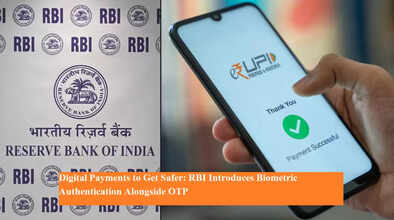Digital Payments to Get Safer: RBI Introduces Biometric Authentication Alongside OTP

The Reserve Bank of India (RBI) has announced a major update to its digital payments security framework, making transactions safer and more flexible for users. Starting April 1, 2026, digital payment systems in India will require mandatory two-factor authentication (2FA), but with a wider range of options beyond the traditional One-Time Password (OTP) sent via SMS.
This new framework is designed to strengthen security in online transactions while giving users more control and convenience. Until now, most digital payments in India required an OTP as the second step of verification, apart from a password, PIN, or biometric login for accessing banking apps. But under the revised guidelines, consumers will soon be able to use biometric authentication methods such as fingerprint or facial recognition to authorize payments.
Why the Change?
With digital payments growing rapidly across India, ensuring the safety of online transactions has become a top priority for regulators. RBI officials highlighted that fraudsters often target OTP-based systems through phishing, SIM swap scams, or malware attacks. By introducing alternative authentication methods, the RBI aims to close security gaps and reduce the risk of unauthorized access.
According to the central bank, all payment system providers—including banks, mobile wallets, and e-commerce payment gateways—will have to comply with the new rule. This means whether you are paying for groceries on a shopping app, transferring money to a friend, or booking tickets online, every transaction will require two layers of verification.
What Changes for Users?
Currently, digital payments work like this:
-
You log into your banking app with a password, PIN, or biometric login.
-
To complete a transaction, you receive an OTP via SMS, which must be entered to authorize the payment.
From April 2026, users will continue to have OTPs as an option, but they can also choose to authenticate payments using biometrics, such as fingerprint scans or facial recognition, depending on their device capabilities and bank’s integration.
This step is expected to make digital payments not only safer but also more seamless. For instance, if you are in an area with poor mobile network coverage and cannot receive OTPs on time, biometric verification could serve as a faster and more reliable alternative.
Two-Factor Authentication Becomes Non-Negotiable
RBI has made it clear that two-factor authentication will remain compulsory for all digital transactions. This means that even with biometrics in place, no transaction can be processed without the dual verification process. The move strikes a balance between convenience and security, ensuring that digital payments remain robust against evolving cyber threats.
Industry and Consumer Impact
Payment service providers will now need to upgrade their systems to support biometric authentication, which could involve significant investment in technology and infrastructure. Mobile phone manufacturers and app developers may also benefit, as demand for devices with strong biometric capabilities is likely to rise.
For consumers, the new rule is expected to bring peace of mind. With multiple authentication options, users can select the method they find most secure and convenient. Experts believe this will also encourage more people to adopt digital payments, especially those who were previously hesitant due to concerns over fraud.
RBI’s Push for a Secure Digital Economy
India has witnessed an unprecedented surge in digital transactions over the last few years, driven by UPI, mobile wallets, and e-commerce platforms. With this rapid adoption comes the responsibility to ensure that consumers’ money and data remain secure. By expanding the scope of 2FA, RBI is reinforcing its commitment to a safe, inclusive, and innovative digital payment ecosystem.
As the April 2026 deadline approaches, banks and payment providers are expected to start rolling out updates and communicating the changes to their customers. For users, the future of digital payments promises to be more secure, faster, and flexible than ever before.

